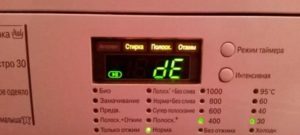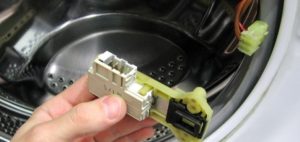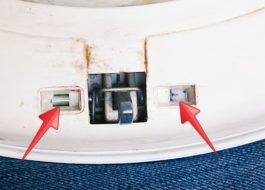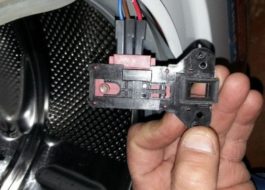LG washing machine hatch won't close
 If the washing machine door does not close, you will have to postpone washing. The smart security system of the machine will not allow you to start drawing water with the hatch half open, so you will have to forget about the laundry loaded into the drum and start looking for the reason for the “stagnation”. In 50% of cases, things “pinched” by the door are to blame for the problem. When there are no visible reasons, it is necessary to look deeper. What causes damage to the lock and how to fix the situation?
If the washing machine door does not close, you will have to postpone washing. The smart security system of the machine will not allow you to start drawing water with the hatch half open, so you will have to forget about the laundry loaded into the drum and start looking for the reason for the “stagnation”. In 50% of cases, things “pinched” by the door are to blame for the problem. When there are no visible reasons, it is necessary to look deeper. What causes damage to the lock and how to fix the situation?
Causes of the problem
It is impossible to immediately and unequivocally answer why the hatch of the LG washing machine does not close with a lock. Several reasons can lead to the lack of fixation. For convenience, the repairmen combined them into two groups.
- Mechanical damage. In this case, the door does not close at all - there is no click of the lock being activated.
- Problems with electronics. If the door slams, but only one click is heard, then there is a problem with the UBL (hatch locking device).
If the door is not closed, the machine will not start washing.
 In the case of a faulty UBL, the machine’s self-diagnosis system will also help - the error code “dE” will be displayed on the display. But in both the first and second options, the machine will not start working, since both the mechanical operation of the lock and the electronic locking are important. Otherwise, the washer simply won’t start.
In the case of a faulty UBL, the machine’s self-diagnosis system will also help - the error code “dE” will be displayed on the display. But in both the first and second options, the machine will not start working, since both the mechanical operation of the lock and the electronic locking are important. Otherwise, the washer simply won’t start.
As a rule, there is either a mechanical or electronic problem. Therefore, you need to forget about washing for a while and switch to troubleshooting. Below are the main “symptoms” and “treatment” for each group of breakdowns.
Mechanics are broken
When the machine does not close at all, then everything points to mechanical damage - a broken lock, a skew or a sagging door. This is caused by natural wear and tear of parts and careless handling of the machine, when the hatch was slammed hard or used as a hanger for heavy things. Among the most common causes is children “skating” on the door.
If the door does not close completely, then a misalignment has occurred. In other words, the hinges have sagged, and the locking mechanism tongue cannot fit into the corresponding groove. To correct the situation, it is necessary to adjust the level and tighten the hatch fastenings.
If everything is in order with the hinges, but there is still no click, then the reason is a skewed “tongue”. Apparently, the metal rod holding the small part in the correct position fell out, and the retainer fell below the mounting groove. To get it into the lock, you will have to disassemble the door and adjust the position of the rod. Another solution would be a comprehensive replacement of the hatch handle, but it all depends on the specific situation.
The third scenario is when the door of the LG washing machine closes, but without the obligatory click. In such a situation, everything points to deformation of the guide, a thin part made of plastic. It is she who is responsible for completely locking the door and with a click notifies that a blockage has occurred. If the door does not lock completely, it means that the plastic hook has worn out or dropped slightly. A slight distortion occurs, which at first glance does not prevent the door from closing. But there is no hit in the key hole, so fixation does not occur. To restore balance, you will need to replace the element.
UBL does not work
Often, at the first stage, the door closes, but the second click, indicating electronic locking, is not heard. At the same time, the error code “dE” is displayed on the display, and the machine stops responding to the “Start” button. In this case, all the blame lies with the failed UBL.
If the door does not lock in the closed position, the system will not start the wash. This is a mandatory safety measure that protects the washing machine from accidentally opening the hatch in the middle of a cycle and, accordingly, from flooding the room. Therefore, complete tightness is achieved in the drum, and for double protection, UBL is activated - electronic locking. UBL may refuse for a number of reasons that need to be discussed.
- Wear. It is possible that over long-term use the bimetallic plates of the electronic lock have worn out and stopped responding to electric current. Repair will not help here, only replacing the UBL.
- Blockage. Often small debris, threads and dirt get inside the locking device, which interferes with the full functioning of the part. The solution is simple - we disassemble the UBL, look for the blockage and clean it out.
- Faulty module. It’s worse if the UBL has stopped reading commands from the control board. More precisely, commands from the control module do not “reach” the lock due to burnt tracks, triacs, or a software failure. To confirm or refute the guess, you need to check the unit, reprogram it, adjust it, or replace it with a new one.
If the first two reasons can be checked independently, then it is better to contact professionals to diagnose the control board. An electronic unit is a very fragile and complex system that requires a special approach and special equipment. Don’t forget about the cost of the part, since the slightest mistake will lead to the module burning out and will require you to spend a hefty amount to purchase a new part.
Checking and replacing UBL
There is no need to immediately start replacing the UBL. First of all, you should make sure that it is faulty. To remove the blocker and inspect it, you need to perform a number of simple steps.
- We disconnect the machine from the power supply and other communications.
- We open the door. The hatch will not open just like that, since the lock is already locked. To remove the “tab”, you will have to tilt the machine on one side, remove the bottom panel and, sticking your hand in, try to manually move the latch. You can try to reach the lock from above: unscrew the lid and tilt the unit back.
- We tighten the hatch cuff: we bend the edge, cling to the clamp and remove it.
- We unscrew the screws holding the lock and remove the locking mechanism.
- We release the connected wiring.
Before disconnecting the wires from the connectors, it is recommended to record the location of the wires on the camera.
Once the device is in your hands, you can begin diagnostics. First, we find the factory instructions for the washing machine and look for the item with the electronic lock circuit. Next, turn on the multimeter to measure resistance, connect the probes to “zero” and “phase” and evaluate the result. If a three-digit number appears on the screen, then the UBL is working properly. Otherwise, replacement is necessary. Next we change the position of the meter to “zero” and the common contact. At "0" or "1" there is nothing to worry about.
If the UBL is not in order, then you should not try to disassemble and repair it. Non-functioning blockers cannot be repaired, but they are also relatively cheap. You just need to tell the seller the serial number of the washer or lock.Installation will also not cause problems - we connect the wires, guided by the photo, carefully fasten them, return the cuff with the clamp and run a test wash. In LG washing machines, door locks often break, and now you know how to check and change a broken UBL. The main thing is not to rush and remember safety precautions.
Interesting:
Reader comments
- Share your opinion - leave a comment




















Add a comment